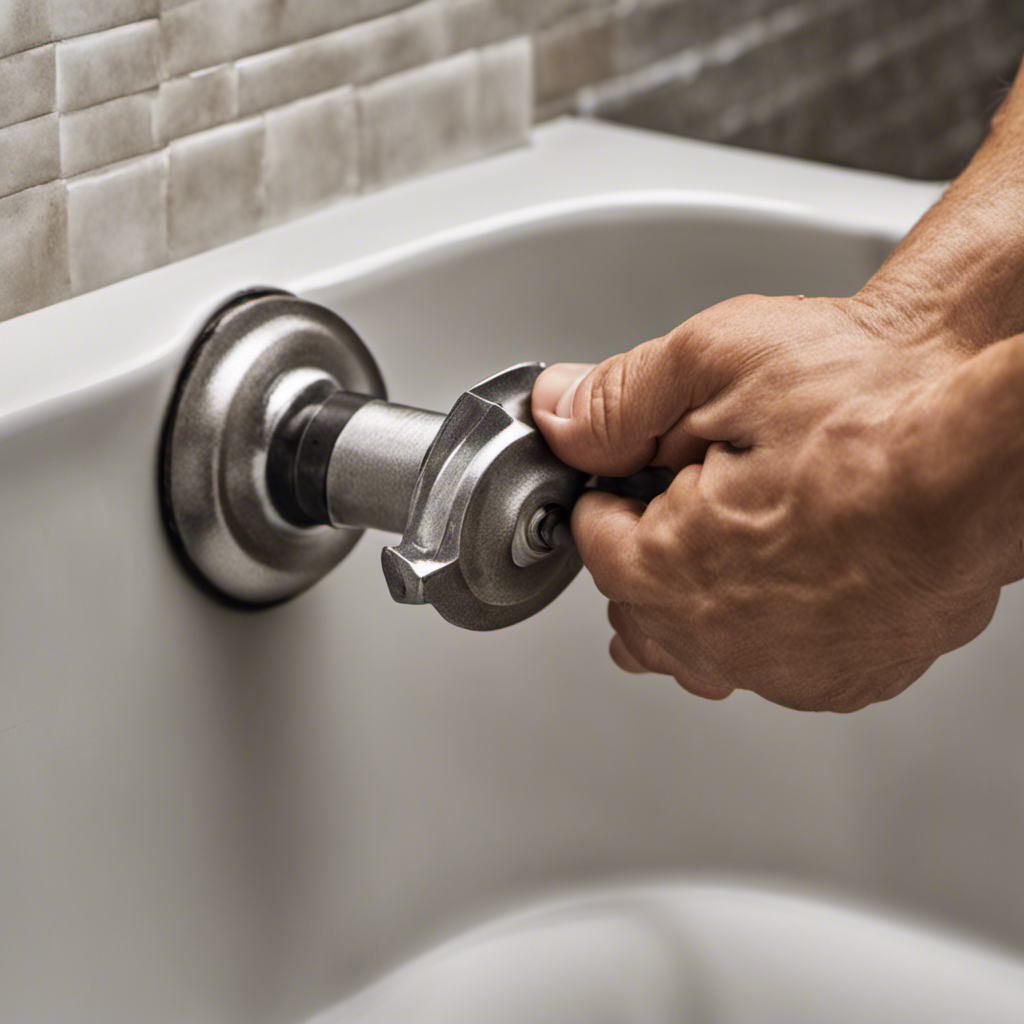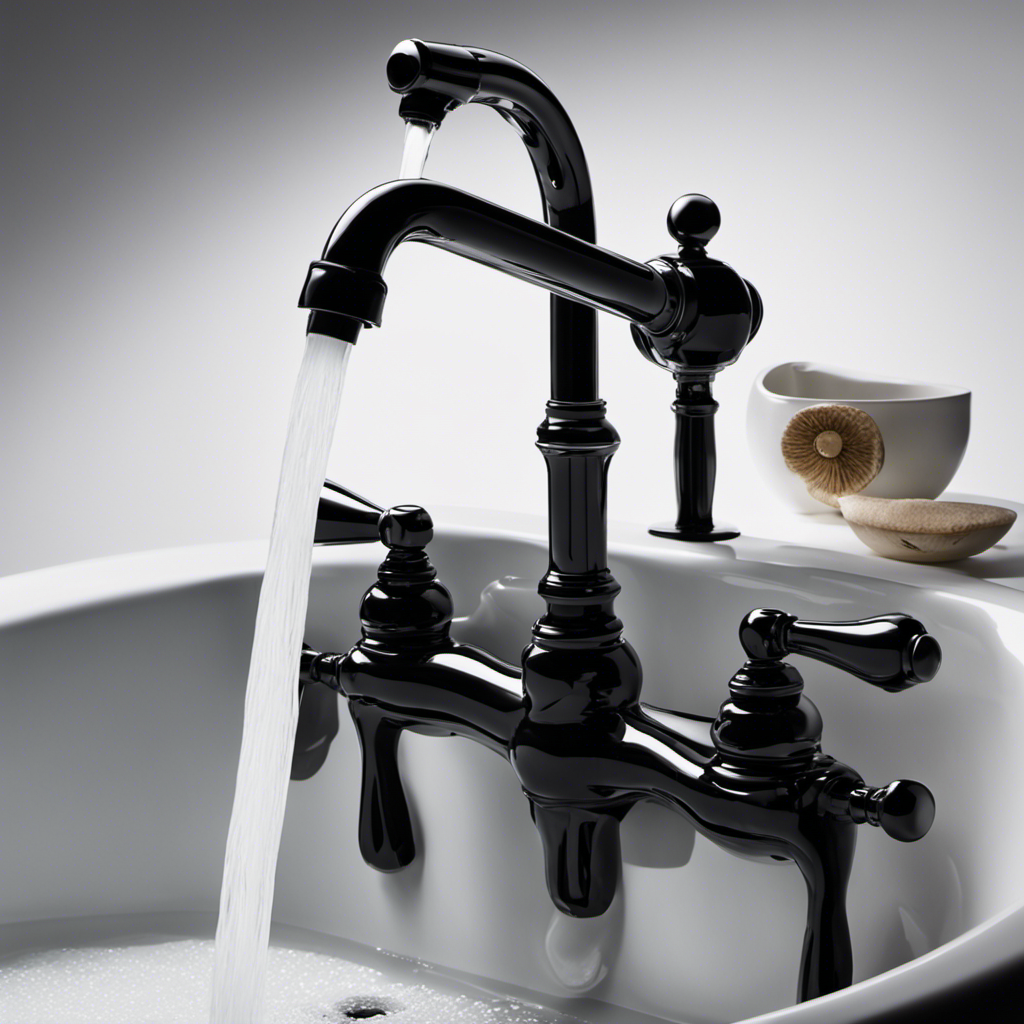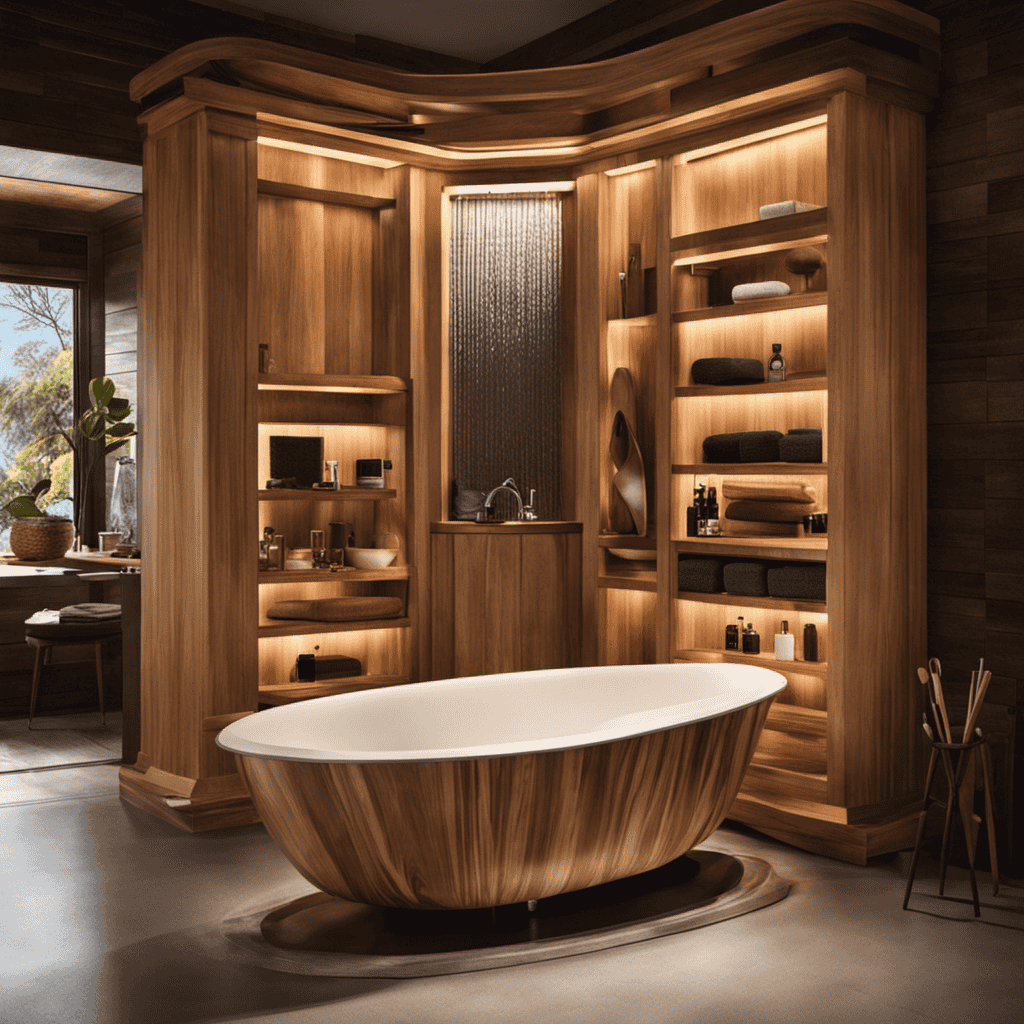Are you tired of your old, worn-out bathtub? Have you been dreaming of a luxurious, spa-like retreat in your own home? Well, it’s time to turn those dreams into reality.
In this article, we will explore the factors that affect bathtub pricing, the different types of bathtubs available, and the costs associated with each option. Whether you’re looking for a basic upgrade or a custom-made masterpiece, we’ve got you covered.
So, grab a towel and let’s dive into the world of new bathtub possibilities.
Key Takeaways
- The price of a new bathtub is influenced by factors such as the material, size, design trends, installation complexity, and personal preferences.
- The cost of different types of bathtubs varies, with clawfoot tubs ranging from $1,000 to $5,000, drop-in tubs starting at around $500, walk-in tubs ranging from $2,500 to $10,000, and freestanding tubs being more expensive compared to built-in tubs.
- The average cost of a basic bathtub is impacted by material cost variations, installation expenses, size, style, and brand.
- The material used for the bathtub also affects the price, with acrylic being affordable and versatile, fiberglass being a budget-friendly option, and cast iron providing a durable and classic look.
Factors Affecting Bathtub Pricing
The cost of a new bathtub can vary depending on factors like material and size. When it comes to bathtub design trends, freestanding tubs are quite popular nowadays. These tubs give a luxurious and modern touch to any bathroom. However, keep in mind that freestanding tubs tend to be more expensive compared to traditional built-in ones.
Another factor that affects the cost is the size of the bathtub. Standard sizes like 60 inches long and 30 inches wide are more budget-friendly, while larger sizes or customized designs can be pricier. It’s important to consider your bathroom space and personal preferences when choosing the size.
Types of Bathtubs and Their Costs
There are various types of bathtubs available and you can find their costs based on your preferences and budget. Here are some options to consider:
-
Clawfoot tubs: These freestanding tubs are a classic choice and can add a touch of elegance to your bathroom. Prices range from $1,000 to $5,000 depending on the material and design.
-
Drop-in tubs: These tubs are installed by dropping them into a deck or alcove. They offer flexibility in terms of size and shape, with prices starting at around $500 and going up to $3,000.
-
Walk-in tubs: These tubs are designed for people with mobility issues, featuring a door for easy access. Prices for walk-in tubs can vary greatly depending on features such as hydrotherapy jets and safety features, ranging from $2,500 to $10,000.
When considering your bathtub refinishing options or looking for luxury bathtub features, it’s important to keep your budget in mind.
Now let’s move on to the next section, where we will explore the average cost of a basic bathtub.
Average Cost of a Basic Bathtub
When considering the average cost of a basic bathtub, there are several key points to keep in mind.
First, material cost variations can greatly impact the overall price of the bathtub. Different materials, such as acrylic, cast iron, or fiberglass, come with different price tags.
Second, it’s important to factor in installation expenses, as these can vary depending on the complexity of the installation and any additional plumbing work required.
Lastly, there are several factors that can affect the price of a basic bathtub, including the size, style, and brand.
Material Cost Variations
Different materials have varying costs when it comes to new bathtubs. The material you choose for your bathtub can greatly impact the overall cost. Here is a comparison of bathtub materials to help you make an informed decision:
-
Acrylic: Acrylic bathtubs are a popular choice due to their affordability and versatility. They are lightweight, easy to clean, and come in a variety of styles and colors.
-
Fiberglass: Fiberglass bathtubs are another budget-friendly option. They are durable, lightweight, and resistant to stains and scratches. However, they may not offer the same level of durability as other materials.
-
Cast Iron: Cast iron bathtubs are known for their durability and classic look. They are heavy and require proper support during installation. Cast iron tubs can be more expensive, but they are built to last.
Consider your budget, style preferences, and maintenance requirements when comparing bathtub materials. Each option has its pros and cons, so choose the one that best fits your needs.
Installation Expenses Included
Consider the installation expenses included when choosing the material for your bathtub. Proper installation is crucial to ensure the longevity and functionality of your new bathtub.
When it comes to bathtub installation, there are a few tips to keep in mind to avoid costly mistakes. Firstly, hiring a professional plumber or contractor is highly recommended. They have the expertise and experience to handle the installation process efficiently and effectively.
Secondly, it’s important to accurately measure the space where the bathtub will be installed to ensure a proper fit. Additionally, be mindful of any plumbing or electrical work that may be required during the installation process. By taking these factors into consideration, you can avoid potential installation mistakes and ensure a smooth and successful bathtub installation.
Moving forward, let’s discuss the factors that can affect the overall price of a new bathtub.
Factors Affecting Price
To accurately determine the factors that affect the overall price, you should consult with a professional plumber or contractor.
However, here are three important factors to consider when it comes to the price of a new bathtub:
-
Bathtub customization options: The more customization options you choose, such as whirlpool jets, handrails, or special finishes, the higher the price will be. It’s important to carefully consider which options are necessary for your needs and budget.
-
Bathtub installation time: The complexity of the installation process can greatly impact the overall cost. If your bathroom requires extensive plumbing or structural changes, it will take more time and effort, resulting in higher installation costs.
-
Bathtub installation cost: The cost of the actual installation will depend on various factors, including the location of your home, the accessibility of the bathroom, and the contractor’s fees. It’s advisable to get multiple quotes from different professionals to compare prices and ensure you’re getting a fair deal.
Upgrading Your Bathtub: Is It Worth the Expense
Is upgrading your bathtub really worth the expense? When it comes to bathtub remodeling, there are several factors to consider. Let’s take a look at the pros and cons of bathtub replacement.
First, let’s talk about the pros. Upgrading your bathtub can give your bathroom a fresh and modern look. It can also increase the value of your home if you’re planning to sell in the future. Additionally, a new bathtub can provide you with a more enjoyable bathing experience, whether it’s a deeper soaking tub or a luxurious whirlpool option.
However, there are also some cons to consider. Bathtub replacement can be expensive, especially if you opt for high-end materials and features. It can also be a time-consuming process, as you may need to hire professionals to install the new bathtub. Furthermore, if your bathroom is small or has limited space, a bathtub replacement may not be feasible.
Custom Bathtub Options and Pricing
If you’re considering customizing your bathtub, it’s important to understand the key points of material and cost, as well as design and price.
When it comes to materials, options such as acrylic, fiberglass, and cast iron can greatly affect the overall cost of your custom bathtub.
Additionally, the design and style you choose can also impact the final price, with options ranging from simple and functional to luxurious and extravagant.
Material and Cost
You can expect to find a variety of materials and costs when shopping for a new bathtub. Here is a comparison of different bathtub materials and some cost-saving tips to help you make an informed decision:
-
Acrylic: This is a popular choice due to its affordability and durability. It is lightweight, easy to clean, and comes in various shapes and sizes.
-
Fiberglass: Another cost-effective option, fiberglass is lightweight and easy to install. However, it may not be as durable as other materials and can be prone to cracking or scratching over time.
-
Cast iron: Known for its timeless elegance and durability, cast iron is a premium choice. It retains heat well but can be heavy and expensive.
Cost-saving tips:
- Consider the long-term costs of maintenance and repairs when comparing prices.
- Look for sales or discounts from reputable manufacturers.
- Shop around and compare prices from different retailers or online platforms.
Design and Price
The design options and prices of different bathtubs vary greatly, allowing you to choose a style that fits your aesthetic preferences and budget. When it comes to bathtub design trends, sleek and modern styles are quite popular.
Freestanding tubs are also in demand, as they create a luxurious and spa-like feel in any bathroom. As for materials, there are cost-effective options available that are both durable and visually appealing. Acrylic and fiberglass bathtubs are great choices if you’re on a budget. They are lightweight, easy to clean, and come in various shapes and sizes.
Another cost-effective material is porcelain-enameled steel. It’s durable, resistant to stains and damage, and offers a classic look. Remember to consider both design and price when choosing a bathtub that suits your needs and preferences.
Hidden Costs to Consider When Installing a New Bathtub
Don’t overlook the hidden costs that come with installing a new bathtub. While the upfront price of the bathtub itself may seem reasonable, there are several additional expenses that you need to consider. Here are three hidden installation fees and unforeseen expenses that you should keep in mind:
-
Plumbing modifications: Depending on the design of your new bathtub, you may need to make changes to your plumbing system. This could involve rerouting pipes or upgrading fixtures, which can add significant costs to your project.
-
Removal and disposal: Before installing a new bathtub, you need to remove the old one. This process can be labor-intensive and may require professional assistance. Additionally, you’ll need to account for the cost of disposing of the old bathtub.
-
Tile and flooring repairs: Installing a new bathtub often requires removing and replacing tiles or flooring around the area. This can lead to unexpected expenses if the existing tiles or flooring are damaged or need repair.
DIY Vs. Professional Bathtub Installation: Which Is More Cost-Effective
If you’re considering bathtub installation, it’s important to weigh the cost-effectiveness of DIY versus hiring a professional.
While doing it yourself may seem like a cheaper option, there are several factors to consider. DIY installation requires purchasing the necessary tools and equipment, which can add up. Additionally, if you make any mistakes during the installation process, you may end up spending more money to fix them.
On the other hand, hiring a professional ensures that the installation is done correctly and efficiently. Professionals have the expertise and experience to handle any challenges that may arise during the installation. While professional installation may be more expensive upfront, it can save you money in the long run by preventing costly mistakes.
Therefore, it’s important to carefully evaluate the cost comparison and consider your own skills and capabilities before deciding which route to take.
Bathtub Materials and Their Price Range
When it comes to bathtub materials, you have several options to choose from.
Two popular choices are fiberglass and porcelain. Fiberglass is lightweight and relatively inexpensive, making it a practical option for those on a budget.
Porcelain, on the other hand, is known for its durability and classic look, but it can be more costly.
Another option to consider is acrylic, which offers a balance between durability and cost.
Fiberglass Vs. Porcelain
You should consider choosing between fiberglass and porcelain for your new bathtub. Here are some factors to consider when making your decision:
-
Fiberglass:
- Pros: Fiberglass bathtubs are lightweight, making them easier to install and maneuver. They are also more affordable compared to porcelain or cast iron options. Fiberglass is a durable material that resists chipping and cracking.
- Cons: While fiberglass is durable, it is not as strong as cast iron or porcelain. It may also fade or discolor over time and can be susceptible to scratches.
-
Porcelain:
- Pros: Porcelain bathtubs are known for their elegance and classic look. They are extremely durable and resistant to scratches, chips, and stains. Porcelain bathtubs also retain heat well, providing a longer and more enjoyable soak.
- Cons: Porcelain bathtubs can be more expensive compared to fiberglass. They are also heavier, making installation more challenging. Porcelain can chip or crack if heavy objects are dropped on it.
Ultimately, the choice between fiberglass and porcelain depends on your budget, aesthetic preference, and the level of durability you desire for your bathtub.
Acrylic Durability and Cost
Acrylic bathtubs are a popular choice due to their durability and affordability. They offer several advantages over other materials.
One of the main benefits of acrylic bathtubs is their resistance to impact and scratches. This makes them extremely durable and long-lasting.
Additionally, acrylic is a non-porous material, which means it is resistant to stains and easy to clean. Maintenance is simple and requires only regular cleaning with mild soap and water.
Another advantage of acrylic bathtubs is their wide range of styles and designs. You can find acrylic tubs in various shapes, sizes, and colors to suit your personal taste and bathroom decor.
Lastly, acrylic bathtubs are lightweight, making them easier to install and handle compared to heavier materials like cast iron or stone.
Stone and Marble Options
Now that you have learned about the durability and cost of acrylic bathtubs, let’s explore another option: stone and marble. These luxurious materials can add a touch of elegance to your bathroom. Here are the pros and cons of stone and marble bathtubs:
-
Durability: Stone bathtubs are incredibly durable and resistant to scratches and chipping. They can withstand heavy use and last for years. On the other hand, acrylic bathtubs are more prone to scratches and may require more maintenance over time.
-
Aesthetics: Stone and marble bathtubs have a timeless beauty that can enhance the overall look of your bathroom. They come in a variety of colors and patterns, allowing you to create a unique and luxurious space. Acrylic bathtubs, while versatile, may not offer the same level of elegance and sophistication.
-
Maintenance: Stone bathtubs may require more maintenance and special cleaning products to keep them looking pristine. They are also heavier and may require professional installation. Acrylic bathtubs, on the other hand, are relatively easy to clean and maintain.
Consider these pros and cons when deciding between a stone or marble bathtub and an acrylic one. Ultimately, the choice will depend on your personal preferences, budget, and the overall aesthetic you want to achieve in your bathroom.
How to Get the Best Deals on New Bathtubs
If you’re looking for the best deals on new bathtubs, it’s important to compare prices and shop around. Getting the best discounts and finding affordable options can save you a significant amount of money. Here’s a practical guide to help you find the perfect bathtub at the best price.
First, start by researching different retailers and online stores. Compare prices and look for any ongoing promotions or discounts. Don’t forget to check out local home improvement stores as well, as they often have competitive prices.
Next, consider purchasing during sales events like Black Friday or end-of-season sales. These are great opportunities to snag a great deal on a new bathtub.
Lastly, don’t be afraid to negotiate with the retailer. Sometimes they may be willing to offer additional discounts or throw in extras like free installation or delivery.
Incorporating a 3 column and 3 row table to compare prices and features of different bathtubs can be incredibly helpful in making a decision. Here’s an example:
| Brand | Model | Price |
|---|---|---|
| Brand A | Model X | $500 |
| Brand B | Model Y | $550 |
| Brand C | Model Z | $600 |
Financing Options for Purchasing a New Bathtub
When considering financing options for a new tub, it’s important to explore different payment plans and interest rates. Here are three options to help you finance your new bathtub:
-
Personal Loan: This is a common option for financing a new bathtub. You can apply for a personal loan from a bank or online lender. Personal loans typically have fixed interest rates and repayment terms, making it easier to budget for your monthly payments.
-
Credit Card: If you have a good credit score, you may be able to finance your new bathtub with a credit card. Some credit cards offer promotional financing options with low or no interest for a certain period of time. Be sure to pay off the balance before the promotional period ends to avoid high interest charges.
-
Home Equity Loan or Line of Credit: If you have built up equity in your home, you could use it to finance your new bathtub. A home equity loan or line of credit allows you to borrow against the value of your home. These options often have lower interest rates compared to personal loans or credit cards.
Remember to compare interest rates, terms, and fees before choosing a financing option for your new bathtub.
How Much Does Bathtub Replacement Cost?
To get an accurate estimate, you should contact a few contractors who can provide you with a cost for replacing your bathtub.
The cost of bathtub replacement can vary depending on several factors, including the type of bathtub you choose, the complexity of the installation process, and any additional features or upgrades you may want.
There are several bathtub replacement options available, including traditional tubs, freestanding tubs, and walk-in tubs. Each option has its own advantages and price range.
The bathtub installation process typically involves removing the old bathtub, preparing the space, and installing the new bathtub. It’s important to hire a professional contractor who is experienced in bathtub installation to ensure that the job is done correctly and to avoid any potential issues down the line.
Frequently Asked Questions
Are There Any Additional Costs Associated With Bathtub Installation Besides the Cost of the Bathtub Itself?
When getting a new bathtub, it’s important to consider additional costs like installation fees and any extra services required. These expenses can vary depending on factors such as plumbing work and the complexity of the installation process.
What Are Some Common Bathtub Materials and Their Pros and Cons?
When it comes to bathtub materials, acrylic and cast iron offer durability and style, while fiberglass and porcelain provide affordability and versatility. Consider your needs and budget to make the right choice.
Are There Any Financing Options Available for Purchasing a New Bathtub?
If you’re wondering about bathtub financing and payment options, there are various options available depending on your credit score and financial situation. Research different lenders and explore their terms and interest rates to find the best fit for you.
What Are Some Ways to Save Money When Purchasing a New Bathtub?
To save money when buying a new bathtub, start by doing a bathtub price comparison. Look for sales and discounts, and consider opting for a DIY installation to avoid paying for professional services.
How Much Does It Typically Cost to Replace a Bathtub?
Replacing a bathtub can vary in cost due to factors like the size of the tub, materials used, and the complexity of the installation process. It’s important to consider these factors when determining the overall cost.
Conclusion
So, if you’re considering getting a new bathtub, there are a few things to keep in mind.
The cost of a new bathtub can vary depending on factors like the type of bathtub, the materials used, and any additional features or customizations. On average, a basic bathtub can cost anywhere from $200 to $500. However, if you’re looking to upgrade your bathtub with features like jets or a whirlpool system, the price can go up significantly.
One interesting statistic to note is that the average cost of bathtub replacement, including labor, is around $3,000. This is definitely an investment, but it can greatly improve the look and functionality of your bathroom.
If you’re looking for a new bathtub, make sure to research different options, compare prices, and consider financing options to find the best deal for you.










